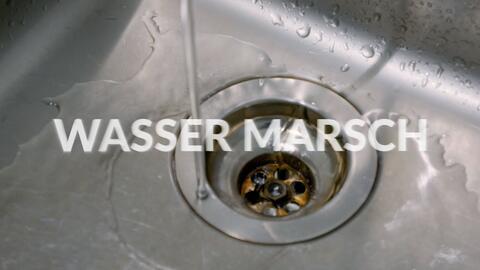Berlin in the grip of Omicron
Anyone infected with the coronavirus, regardless of whether or not they are symptomatic, excretes the virus’s genetic material – and not just via breath or saliva: The RNA of SARS-CoV-2 can also be found in the stool of those infected. And this information is quickly carried via wastewater to sewage treatment plants.
In February 2021, several teams from the Max Delbrück Center for Molecular Medicine in the Helmholtz Association (MDC) began searching for the genetic material of the novel coronavirus in Berlin’s wastewater. They sequenced these data, interpreted them, and presented the results visually in descriptive graphs. Along with other colleagues, Vic-Fabienne Schumann and Dr. Rafael Cuadrat from Dr. Altuna Akalin’s Bioinformatics and Omics Data Science Platform have now published the outcome of their joint work. Dr. Akalin coordinated the project. With this publication the tool developed at the MDC is now available to other interested scientists.
From five to 90 percent in four weeks
Since December the MDC researchers have also been searching for the new Omicron variant. The first preliminary results are now available: Omicron’s share in the wastewater samples examined by the MDC grew rapidly over the course of December 2021 – jumping from five percent on December 8 to 40 percent on December 23 and then up to 65 percent on December 29. On January 5, 2022, the new variant had soared to 90 percent, virtually displacing the Delta variant. The result confirms analyses made by the laboratory of Berlin’s water supply company, Berliner Wasserbetriebe, which also found Omicron to be increasing over the course of December.
The scientists filter the brown broth, enrich the virus particles they find, and isolate and sequence the virus’s genome.
It was Professor Nikolaus Rajewsky who came up with the idea of examining the murky waters of Berlin’s sewage system to obtain rapid and detailed information on the spread of the coronavirus in the German capital. The Scientific Director of the MDC’s Berlin Institute for Medical Systems Biology (BIMSB) approached the Berliner Wasserbetriebe, which was only too happy to make its wastewater available for research purposes.
The resulting tool, a data analysis pipeline called PiGx SARS-CoV-2, has now been described in detail by the researchers on the preprint server medRxiv. “This is a computer-based tool that allows us to graphically display infection dynamics and the SARS-CoV-2 variants that are in circulation at different locations simultaneously,” Schumann explains. “The most important things to feed into this end-to-end pipeline are the results of the RNA sequencing from the wastewater, information about the relevant variants, and some ancillary information about the data.”
The results, which PiGx SARS-CoV-2 displays as graphs, are not dependent on people taking Covid-19 tests or developing symptoms. They can also serve as an early warning system, Schumann explains, as they reliably predict whether incidence rates will increase or decrease over the coming days.
Early detection of new variants
To test their pipeline, the researchers analyzed a total of 38 wastewater samples from four Berlin sewage treatment plants between February and June 2021. “Using our tool, we were able to reconstruct the dynamics of the Alpha variant of concern, and we also detected the signature mutation of the Delta variant and its rise in early June,” Schumann reports. “We have therefore demonstrated that the pipeline works.”

Wastewater sequencing at the MDC is primarily carried out by Professor Markus Landthaler’s BIMSB lab RNA Biology and Posttranscriptional Regulation. “The major advantage with our computer-assisted methods is that we can simultaneously search for all known variants while also possibly detecting new mutations earlier than has previously been possible,” explains Dr. Emanuel Wyler, a postdoctoral researcher in the Landthaler Lab. “Using the mathematical models we have developed, it may even be possible to detect variants of concern before they become clinically relevant.”
Berlin lawmakers to debate sewage surveillance program
The team is currently refining the targeted monitoring of wastewater for variants like Omicron and working to reconstruct infection dynamics. “There are still uncertainties surrounding how well our methods are able to identify entirely new variants,” explains Schumann. “It is not yet clear whether the viral RNA in wastewater is as complete as it is in the blood of patients.”
Wastewater samples arrive well-chilled at the MDC.
Wastewater testing is not yet an established part of Germany’s Covid-19 early warning system – for either known or new variants. But, that said, the Berliner Wasserbetriebe has been using its own funds to regularly monitor several points along the city’s wastewater network since July 2021 and has been in contact with the Berlin Senate and the Berlin State Office for Health and Social Affairs (LaGeSo) LAGeSo regarding these activities. Policymakers are currently discussing whether a nationwide monitoring program should be set up and financed with EU money – and what role Berlin can play in this. On January 19, 2022, there will be a hearing in the Main Committee of the Berlin House of Representatives on this issue with the Berliner Wasserbetriebe, which will present data collected by the MDC.
“Other countries like Sweden, the Netherlands and Italy are much further along with this,” says MDC researcher Schumann. “But perhaps our tool will help to change the situation here in Germany too.”
Literature
Vic-Fabienne Schumann, Rafael Ricardo de Castro Cuadrat, Emanuel Wyler et al. (2021): „COVID-19 infection dynamics revealed by SARS-CoV-2 wastewater sequencing analysis and deconvolution“. MedRxiv, DOI: 10.1101/2021.11.30.21266952
Please note: This manuscript is being made available to the scientific community on a preprint server. It has not yet been certified by peer review. As the authors may have to edit or make additions to the manuscript, it may take some time until journal publication occurs. Notwithstanding this, the MDC is presenting the research here as the subject matter is of high urgency due to the rapid spread of the Omicron variant of concern.
Further information
Downloadable images
- Wastewater samples arrive well-chilled at the MDC. Photo: Felix Petermann, MDC
- The scientists filter the brown broth, enrich the virus particles they find, and isolate and sequence the virus’s genome. Photo: Felix Petermann, MDC
- Wastewater sample before sequencing. Photo: Felix Petermann, MDC
Contact
Jutta Kramm
Head of Communications
Max Delbrück Center for Molecular Medicine in the Helmholtz Association (MDC)
+49-30-9406-2140
jutta.kramm@mdc-berlin.de or presse@mdc-berlin.de
Max Delbrück Center for Molecular Medicine in the Helmholtz Association (MDC)
The Max Delbrück Center for Molecular Medicine in the Helmholtz Association (MDC) is one of the world’s leading biomedical research institutions. Max Delbrück, a Berlin native, was a Nobel laureate and one of the founders of molecular biology. At the MDC’s locations in Berlin-Buch and Mitte, researchers from some 60 countries analyze the human system – investigating the biological foundations of life from its most elementary building blocks to systems-wide mechanisms. By understanding what regulates or disrupts the dynamic equilibrium in a cell, an organ, or the entire body, we can prevent diseases, diagnose them earlier, and stop their progression with tailored therapies. Patients should benefit as soon as possible from basic research discoveries. The MDC therefore supports spin-off creation and participates in collaborative networks. It works in close partnership with Charité – Universitätsmedizin Berlin in the jointly run Experimental and Clinical Research Center (ECRC), the Berlin Institute of Health (BIH) at Charité, and the German Center for Cardiovascular Research (DZHK). Founded in 1992, the MDC today employs 1,600 people and is funded 90 percent by the German federal government and 10 percent by the State of Berlin.










